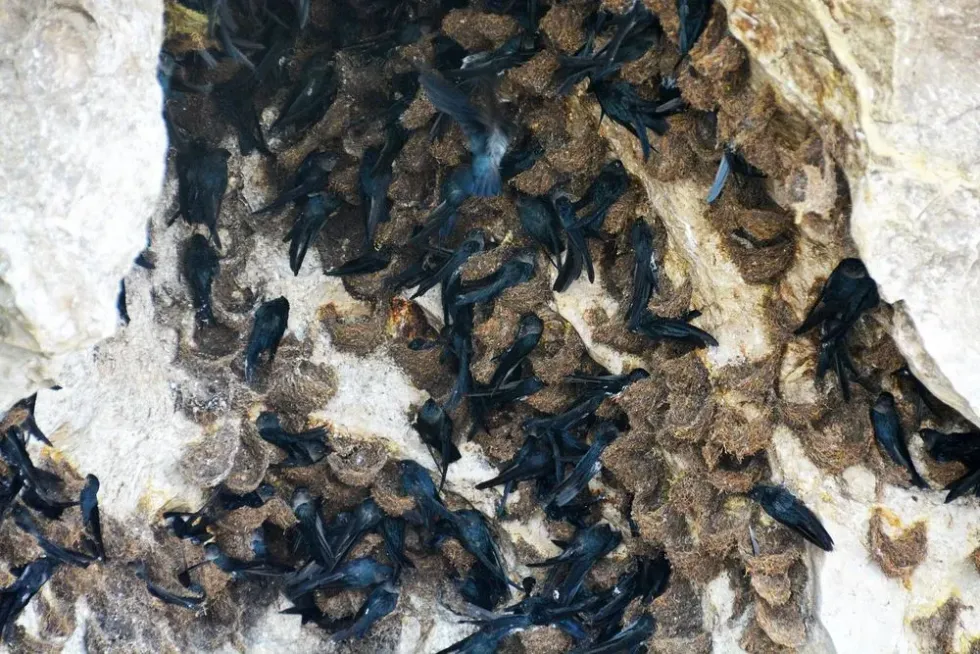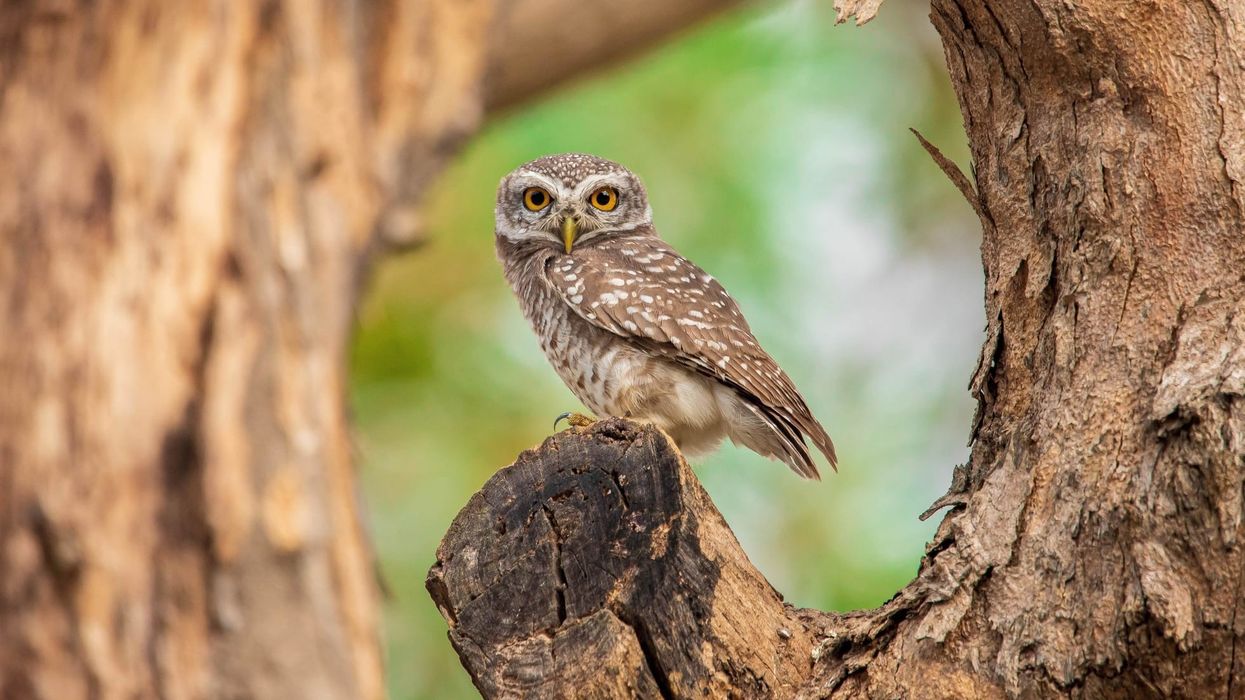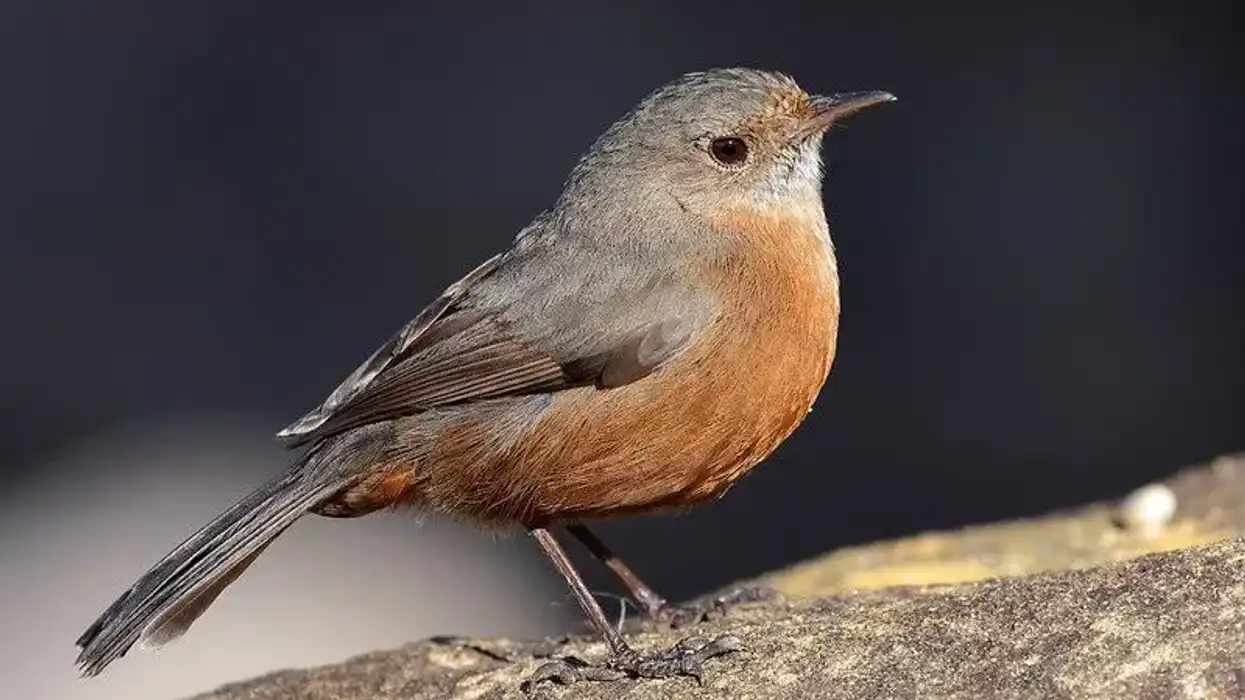The name cave swiftlet (Collocalia linchi) leaves no room for guessing the habitat of these animals. These cave-dwelling animals from the family of swifts are rather interesting, in spite of the monotonous plumage that might mislead you into thinking otherwise.
Other than caves, they also live in dense tropical forests and in temperate climates. They are quite adaptive when it comes to climatic conditions, but make no compromises with lighting situations.
Groups of cave swiftlets roost in complete darkness, much like bats. They also breed in the darkness, and the female cave swiftlet can sometimes be seen to be laying eggs in a nest that is not her own.
These birds are mostly dark brown, dark gray, or black in color and may sometimes have a few white feathers here and there. The wings are rounded and the bill is considerably short.
They do not have tufts of hair on their hind toes, unlike glossy swiftlets and hairless bats, which is a distinguishing feature. These birds are natives of South-east Asia and surrounding places such as Thailand, Indonesia, Malaysia, and India.
One interesting fact to get you curious about this species is that they have edible birds nests and these nests are a popular find at a Chinese market.
If you would like to read about more birds, make sure to check out the American pipit and blue jay here at Kidadl!
Cave Swiftlet Interesting Facts
What type of animal is a cave swiftlet?
The cave swiftlet (Collocalia linchi) is a bird that belongs to the family Apodidae, and it is mostly observed in flight. The members of the family Apodidae roost in caves at night.
What class of animal does a cave swiftlet belong to?
In scientific terms, the class that these birds belong to is Aves. However, in more popular language, we classify them as birds.
How many cave swiftlets are there in the world?
There are no studies that tell us the exact number of nesting cave swiftlets there are in the world, simply because they are not an endangered or threatened species and their population is quite large.
Where does a cave swiftlet live?
The cave swiftlet (Collocalia linchi) lives in caves, specifically cave walls.
This species and other related species such as the nest swiftlet (Aerodramus fuciphagus) and glossy swiftlet (Collocalia esculenta) prefer to roost in the darkness of caves, although, they are not a nocturnal species like the hoary bat which is a bird species that has similar roosting habits.
They live near waterfalls and in temperate or tropical forests, since the only factor that dictates their choice of building a nest is that they are provided with sufficient darkness and safety.
What is a cave swiftlet's habitat?
The habitat range of cave swiflet (Collocalia linchi) birds extends throughout South-east Asia including Indonesia, India, Thailand, and Malaysia. These birds find sites to build their homes in any dark cliff-like place that can give them enough seclusion from other predatory species and from light.
If you are wondering how these birds can see in total darkness, the cave swiftlet vision is remarkably good and they can navigate with the help of echolocation.
Who do cave swiftlets live with?
Cave swiftlet (Collocalia linchi) birds are a colonial species which means that they form large groups in order to roost. Each cave that they choose to inhabit hosts a large population which builds individual nests, or one for each mated pair along cave walls.
They, however, they are believed to be quite territorial since their list of preferred sites for nesting is so narrow. There can also be the distance of hundreds of miles (or kilometers) between two such large cave swiftlet communities.
It is also interesting to note that the nests of some species of swiftlet birds are used for a Chinese delicacy, the Chinese bird's nest soup.
How long does a cave swiftlet live?
The average lifespan of the cave swiftlet (Collocalia linchi) is of around 15-18 years!
How do they reproduce?
The exact breeding habits or the breeding season of this bird species is not known, however, they do have a ritual that is quite interesting. In some instances, these birds lay their eggs in another cave swiftlet's nest.
Such can be case for reasons like communal parenting or nest parasite-ism. They form large groups in order to roost in caves.
Male and female swiftlets take up equal responsibility of raising the chicks or juveniles, right from incubation to fledging.
What is their conservation status?
According to the IUCN, the conservation status of the cave swiftlet is of Least Concern. However, of the 30 species of swift or swiftlet birds that are known, six are known to be Endangered. This cave swiftlet Endangered status could because their nests are harvested by people to sell in markets.
Cave Swiftlet Fun Facts
What do cave swiftlets look like?
The list of features that describe a cave swiftlet is rather narrow. These birds are thoroughly dark brown, black, or dark gray in color and have wings that may sometimes have white feathers to break the otherwise monotonous color scheme.
It may in fact sometimes become very tough for the observer to differentiate these birds from the dark caves that they inhabit.
How cute are they?
While they do not fit into the quintessential idea of a cute bird that has colorful feathers and a beautiful beak, the cave swiftlet does strike a gentle chord with some people.
Whoever said that beauty lies in the eyes of the beholder wasn't wrong, and so we will let you judge from the cave swiftlet photo whether or not you think it is cute.
How do they communicate?
The exact means of communication used by these colonial Malaysian birds is not known to us, but they may use echolocation to catch prey. They do have a rather cute call that they make mostly while in flight. The call, to our humble ears, sounds like a 'cheer-cheer'.
How big is a cave swiftlet?
The range of the cave swiftlet's length is around 3.5-4.5 in (9-11.5 cm). For a comparative view, these swifts are about twice the size of hummingbirds.
How fast can a cave swiftlet fly?
There are no records that tell us the exact speed at which this bird species can fly, however, the range of speed can be understood to be quite high from the account of observers who have seen these glorious cave swiftlets in flight.
How much does a cave swiftlet weigh?
The average weight of a cave swiftlet has a range of around 0.4 oz (14 g). These birds are half as heavy as an average purple finch and a northern saw whet owl is about seven times as heavy.
What are the male and female names of the species?
There are no distinguished names for males and females, just like there is hardly any difference in their physical appearance. We simply refer to them as a male cave swiftlet and a female cave swiftlet.
What would you call a baby cave swiftlet?
The baby cave swiftlet will have the same names as all juveniles of the Aves class. Baby swiftlets are called chicks or nestlings.
What do they eat?
The cave swiftlet has a strictly insectivorous diet. This bird catches insects while in flight, instead of bringing them back to the nests.
Are they poisonous?
Cave swiftlets are not known to be poisonous and they are not known to cause any harm to humans or other animal species. The nests of this species and related species are in fact sold in the Chinese market, specifically to make edible bird nest soup.
Would they make a good pet?
The cave swiftlet species is not commonly domesticated. The habitat of this species would be exceptionally tough to mimic in any household, and their diet would also be a hassle to keep up with. It would therefore be best to not consider this species as a member of your family.
Did you know...
The glossy swiftlet (Collocalia esculenta) is slightly different from these birds in the way that they have a tuft of hair on their hind toes which cave swiftlets do not.
White-nest swiftlet nests and black-nest swiftlet nests are edible, and collected for use in Chinese cuisine. These nests are considered a delicacy which is made out of the swift bird's saliva.
Six swiftlet species are believed to be Endangered.
The cave swiftlet echolocation ability is one of its most interesting behavior traits.
Swiftlet refers to any swift bird that lives in caves. The cave swiftlet meaning is also similar and is mostly because of their habits of making nests in the caves.
What reason might swiftlets have for living in caves?
Some scientists have understood that cave swiftlet predation risk high, and so, their reason for building nests in caves could be a survival strategy.
What is a cave swiftlet nest made of?
The nests of cave swiftlets are mostly made with saliva and other bits and pieces that they may find. The nest of the white nest swiftlet (Aerodramus fuciphagus) is considered a delicacy by Chinese people and bought for much higher prices than the nest of the black nest swiftlet (Aerodramus maximus).
This because the Chinese delicacy 'bird's nest soup' is made best and most authentically with white nests that have been made mostly with the saliva of white nest swiftlet birds.
Here at Kidadl, we have carefully created lots of interesting family-friendly animal facts for everyone to discover! Learn more about some other birds from our whiskered treeswift facts and umbrellabird facts pages.
You can even occupy yourself at home by coloring in one of our free printable Cave swiftlet coloring pages.










